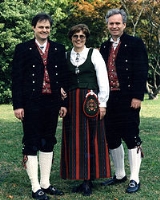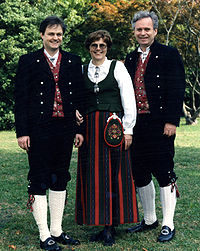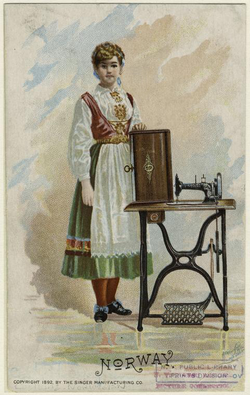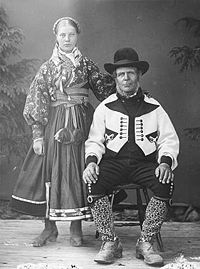
Bunad
Encyclopedia

The Bunad movement has its root in 19th century national romanticism, which included an interest for traditional folk garments not only in Norway
Norway
Norway , officially the Kingdom of Norway, is a Nordic unitary constitutional monarchy whose territory comprises the western portion of the Scandinavian Peninsula, Jan Mayen, and the Arctic archipelago of Svalbard and Bouvet Island. Norway has a total area of and a population of about 4.9 million...
, but also in neighbouring countries such as Denmark
Denmark
Denmark is a Scandinavian country in Northern Europe. The countries of Denmark and Greenland, as well as the Faroe Islands, constitute the Kingdom of Denmark . It is the southernmost of the Nordic countries, southwest of Sweden and south of Norway, and bordered to the south by Germany. Denmark...
and notably Germany
Germany
Germany , officially the Federal Republic of Germany , is a federal parliamentary republic in Europe. The country consists of 16 states while the capital and largest city is Berlin. Germany covers an area of 357,021 km2 and has a largely temperate seasonal climate...
. However, in Norway
Norway
Norway , officially the Kingdom of Norway, is a Nordic unitary constitutional monarchy whose territory comprises the western portion of the Scandinavian Peninsula, Jan Mayen, and the Arctic archipelago of Svalbard and Bouvet Island. Norway has a total area of and a population of about 4.9 million...
national romanticist ideas had a more lasting impact, as seen in the use of folk inspired costumes.
Designs and popularity
The designs are typically elaborate, with embroideryEmbroidery
Embroidery is the art or handicraft of decorating fabric or other materials with needle and thread or yarn. Embroidery may also incorporate other materials such as metal strips, pearls, beads, quills, and sequins....
, scarves, shawls and hand-made silver
Silver
Silver is a metallic chemical element with the chemical symbol Ag and atomic number 47. A soft, white, lustrous transition metal, it has the highest electrical conductivity of any element and the highest thermal conductivity of any metal...
or gold
Gold
Gold is a chemical element with the symbol Au and an atomic number of 79. Gold is a dense, soft, shiny, malleable and ductile metal. Pure gold has a bright yellow color and luster traditionally considered attractive, which it maintains without oxidizing in air or water. Chemically, gold is a...
jewelry known as sølje. There are bunads both for men and women, although women's bunads are more diverse and popular. However, according to daily manager Turid Liss Agersborg at Husfliden Oslo, they now produce and sell more men’s bunads than women’s for the first time in history. The male customers are often characterized as urban and modern, and range between the ages of 20 and 40 years old.
A number of books on the history of bunads recount the story of how once when on holiday in Hardanger
Hardanger
Hardanger is a traditional district in the western part of Norway, dominated by the Hardangerfjord. It consists of the municipalities of Odda, Ullensvang, Eidfjord, Ulvik, Granvin, Kvam and Jondal, and is located inside the county of Hordaland....
with her Danish husband the British Princess Maud of Wales
Maud of Wales
Princess Maud of Wales was Queen of Norway as spouse of King Haakon VII. She was a member of the British Royal Family as the youngest daughter of Edward VII and Alexandra of Denmark and granddaughter of Queen Victoria and also of Christian IX of Denmark. She was the younger sister of George V...
thought that the Hardanger bunads worn by the women in Hardanger were so beautiful that she had one made for her. At that time she could have had no inkling that a decade and a half later she would return to Norway as its queen, the matriarch of a new dynasty of Norwegian kings. She later wore this Hardanger bunad at numerous public appearances in Norway, a tradition maintained by the present Queen Sonja, the Crown Princess Mette Marit and Princess Martha Louise, although Queen Sonja and her daughter wear the East Telemark bunads, Telemark
Telemark
is a county in Norway, bordering Vestfold, Buskerud, Hordaland, Rogaland and Aust-Agder. The county administration is in Skien. Until 1919 the county was known as Bratsberg amt.-Location:...
being the ancestral county of the Queen's own family.
Bunad traditions in Norway

Norwegian Constitution Day
Norwegian Constitution Day is the National Day of Norway and is an official national holiday observed on May 17 each year. Among Norwegians, the day is referred to simply as syttende mai or syttande mai , Nasjonaldagen or Grunnlovsdagen , although the latter is less frequent.- Historical...
celebrations. In recent years, its use has reached far outside folk dancing, folk music, and particular holidays. Accepted as proper gala attire, it is increasingly common to see people, and especially women, dressed in bunad. The former Norwegian foreign minister, Thorvald Stoltenberg
Thorvald Stoltenberg
Thorvald Stoltenberg is a former Norwegian politician. His ancestors stem from Northern Germany and emigrated to Norway in the 17th century. He served as Minister of Defense and Minister of Foreign Affairs in two Labour governments.From 1989 to 1990 he was appointed Norwegian Ambassador to the UN...
, made history by presenting his accreditation as ambassador to Margrethe II of Denmark
Margrethe II of Denmark
Margrethe II is the Queen regnant of the Kingdom of Denmark. In 1972 she became the first female monarch of Denmark since Margaret I, ruler of the Scandinavian countries in 1375-1412 during the Kalmar Union.-Early life:...
dressed in a bunad. Bunads were also conspicuous among those present at the Blessing of the Reign of King Harald and Queen Sonja, demonstrating that the bunad is now considered acceptable as an alternative form of formal wear even on the most solemn public occasions. Moreover, people tend to wear bunads to festive celebrations such as anniversaries and birthdays, and for religious occasions including baptisms, confirmations and Christmas.
There is ongoing debate about the official status of various outfits, and what allowed variations are. In 1947 an official institution, the Landsnemda for Bunadspørsmål, was organized to act in an advisory capacity on all questions dealing with bunads in Norway. Due to ongoing discussions on the status of bunads, it is not possible to state accurately the number of different types of bunads in Norway, but most estimates place the number at around 200.
From the late 19th century until quite recently the image which was most commonly used to represent the Norwegian traditional rural dress in general was that of the Hardanger woman's bunad, but in more recent times this image is being increasingly superseded by that of the East Telemark woman's bunad.
Design and origins of bunad

Norwegian romantic nationalism
Norwegian romantic nationalism was a movement in Norway between 1840 and 1867 in art, literature, and popular culture that emphasized the aesthetics of Norwegian nature and the uniqueness of the Norwegian national identity...
and gained increasing interest with the folk-dance movement at the beginning of the 20th century.
In some parts of the country, folk-costume tradition was alive as late as the early 19th century. Bunads with such long traditions are to be found in the Bergen area on the west coast, in Setesdal
Setesdal
Setesdal is a valley and a traditional district in Aust-Agder County in southern Norway. It consists of the municipalities of Bykle, Valle, Bygland, Iveland, and Evje og Hornnes....
in the south, in some districts of Telemark
Telemark
is a county in Norway, bordering Vestfold, Buskerud, Hordaland, Rogaland and Aust-Agder. The county administration is in Skien. Until 1919 the county was known as Bratsberg amt.-Location:...
, Numedal
Numedal
Numedal is a traditional district and valley Buskerud, Norway. Running north–south, it extends between Kongsberg in the south to Rødberg in the north, passing through the municipalities of Kongsberg, Flesberg, Rollag and Nore og Uvdal.. The river Numedalslågen, the third-longest in the country,...
, Hallingdal
Hallingdal
Hallingdal is a valley and traditional district in Buskerud county in Norway. It consists of the municipalities of Flå, Nes, Gol, Hemsedal, Ål and Hol.-History:Ancient routes went to Vestlandet through Valdres and Hallingdal and down Røldal to Odda...
, and Gudbrandsdal
Gudbrandsdal
The Gudbrandsdalen is a valley and traditional district in the Norwegian county of Oppland. The valley is oriented in a north-westerly direction from Lillehammer at Mjøsa, extending 230 km toward Romsdal...
, and at Røros
Røros
is a town and municipality in Sør-Trøndelag county, Norway. It is part of the Gauldalen region. The administrative centre of the municipality is the town of Røros. Other villages include Brekken, Glåmos, Feragen, Galåa, and Hitterdalen....
in eastern Norway. The names of these traditional bunads are based on their geographic origin, and traditionally, people choose their bunad based on their own or their ancestors’ origin.
Hulda Garborg
Hulda Garborg
Hulda Garborg was a Norwegian writer, novelist, playwright, poet, folk dancer, and theatre instructor...
(1862–1934) and Klara Semb (1884–1970) are cited as pioneers in bringing bunads into mainstream culture. With Garborg's publication of the pamphlet Norsk Klædebunad in 1903, the focus moved from the creation of a single national costume to the development of several regional bunads. Although bunads are based on traditions in various areas, these designs are embellished by additions such as embroidery. The overarching sense of bunad design is to preserve the way people dressed for festive occasions in one particular era. This has led local and national councils to impose official constraints on various details in the bunad, including colors, fabric, embroidery, jewellery, cut, and allowable headwear.
The Bunad movement

Lise Skjåk Bræk
Lise Skjåk Bræk is a Norwegian textile artist, known for her works within ceremonial apparel, uniforms, costumes, rugs, and other textiles. She is a resident of Trondheim....
have developed entire lines of costumes based on the bunad tradition. In the field of folk costumes it is common to differentiate between bunad and folk costume, the latter being the local dress in previous times with all its variations and use. Bunads are used for festive occasions and today they date back to the folk costume tradition of the 19th century.
There is a continuing debate about the extent to which bunads must conform to the standards, or whether it is acceptable to vary or improvise based on general themes. Some groups (sometimes derisively referred to as the bunad police) argue that bunads must be sewn and worn according to strict standards; others advocate a more creative, lenient approach. Although these differing groups show little sign of reaching consensus, both factions agree that traditional under-garments—commonly known as frillies — should be worn with the Bunad.
Bunads are nowadays often viewed as a status symbol, ranging in the price of $2,000 - 10,000, depending on the desired design, material, embroidery, gold, silver and accessorizes. The price also depends on whether the customer buys from a well established company like Husfliden, from local sewers or decides to sew or do part of the embroidery themselves. It usually takes up to a year to finish making the bunad, and it has become a tradition for parents to give their children a bunad as a confirmation gift, which they will wear on their confirmation day.
Criticizing that only wealthy people can afford to purchase a bunad and to carry out this tradition, Norske Bunader moved the production of some Norwegian bunads to China. This shift has lowered the price and made the national costume more affordable. It has also caused major concerns by patriotic citizens who believe the Norwegian national costume should be completely authentic and only produced domestically. Although some people argue that traditional bunad producers such as Husfliden and Heimen contradict themselves by having immigrants sew bunads and make embroideries at their company, they respond by claiming that the immigrants are equally licensed as Norwegian sewers and that the bunads are still made in Norway.
Other sources
- Fossnes, Heidi Norges bunader og samiske folkedrakter (Cappelen. Oslo: 1993) ISBN 82-02-13874-4 http://urn.nb.no/URN:NBN:no-nb_digibok_2008040304020
- Noss, Aagot Adolph Tidemand and the Norwegian Folk Costumes (Universitetsforlaget. 1981) ISBN 8200057127
- Scheel, Ellen Wigaard Norske drakter, stakker og bunader (N.W. Damm. 2001) ISBN 82-512-0585-9

